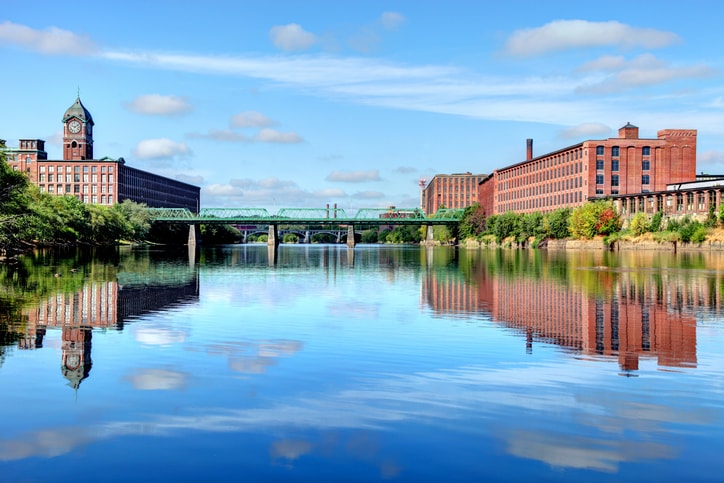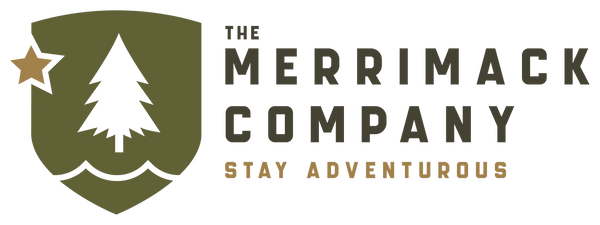
Digging Into the History of Fashion in The Merrimack Valley - Pt. 1 Lawrence
Share
Digging Into the History of Fashion in The Merrimack Valley - Pt. 1 Lawrence
The Merrimack Company is headquartered in a converted mill building on the banks of the Merrimack River in Lawrence, Massachusetts. Our founding in Lawrence is a purposeful nod to the history of fashion manufacturing, and the Industrial Revolution, that took place in Lawrence on the banks of the Merrimack.
This New England city is known as the Immigrant City, with deep roots in the fashion industry due to the manufacturing of textiles, apparel, and footwear. Ambitious immigrants from Ireland, Italy, Canada, England, and Germany came to the city to find work in the mills in the late 1800s, followed by many other immigrant groups in the 1900s, and continues to be an ethnically diverse city today, including a strong presence of Puerto Rican and Dominican residents.
Lawrence is also still a manufacturing hub. The city is home to several well-known companies and brands that manufacture apparel, footwear, and textiles.
However, for history buffs, Lawrence is best known for being the scene of the Lawrence Textile Strike—also known as the Bread and Roses Strike—an important point in American history regarding labor rights. To give you a better idea of why this is significant, here’s a down and dirty history on the founding of Lawrence, the importance of the Merrimack River, and the part Lawrence played in the American Industrial Revolution.
The Merrimack River Valley
The Merrimack Valley region, located a short drive from Boston, is an excellent place for visitors and residents alike to enjoy changing seasons, local attractions and entertainment, and robust culture. At the heart of the Merrimack Valley is the Merrimack River.
According to the Environmental Protection Agency, the Merrimack River is a 115-mile waterway that begins in central New Hampshire and winds south into Massachusetts before turning east and emptying in the Atlantic Ocean in Newburyport, MA. Today, the Merrimack is the fourth largest watershed in New England, and provides drinking water for nearly 500,000 people in Massachusetts.
While the Merrimack is a source of drinking water and a beautiful place to recreate today, its industrial past negatively affected the surrounding ecosystems as the result of poor water and environmental practices. In the mid-1800s, the power of the Merrimack River was harnessed to supply energy for a growing manufacturing presence.
Lawrence, Massachusetts’ Origin Story
Abbott Lawrence, an American merchant, was a major developer of the textile industry in New England. His involvement in building large cotton and wool cloth mills and designating the area as a textile center was the primary driver of the founding the city of Lawrence, his namesake.
In 1843, Abbott Lawrence partnered with a group of influential families and Boston entrepreneurs to form the Essex Company to harness the power of Bodwell’s Falls on the Merrimack River. In just three years, the Essex Company completed a dam, two canals, and a reservoir, as well as mill buildings, boarding houses, and other utilities needed to support manufacturing along the river.
Lawrence, the city, is positioned outside of Boston, MA, which became the world’s first rail hub in 1835. Lawrence, the merchant, was a prominent supporter of New England railways, and alongside other entrepreneurs and merchants, they were able to extend their influence and bring trade inland from Boston ports. In 1847, the passenger train service was introduced to the region and Lawrence was incorporated as a city.
When you consider the history of fashion in Lawrence and New England and the part it played in American history, you can’t ignore how the rapid growth of manufacturing along the region’s waterways contributed to the American Industrial Revolution.
The American Industrial Revolution
There are many reasons for the rapid growth of manufacturing in America, dating back to the early 1800s and causing a trickle-down effect through the middle of the century. The Embargo Act of 1807, which was legislation passed by Congress, restricted American exports and restricted imports from Britain. The lack of access to foreign goods was a driver for Americans to begin producing their own goods.
Later, the War of 1812 resulted in a blockade of British ships along the eastern coast of America, effectively bringing fishing and shipping to a halt. This further pushed Americans to focus on production rather than trade for goods, including textiles.
The abundance of natural resources and readily available labor in America made the Industrial Revolution boom. All industries benefited from easy access to timber, coal, and water to power manufacturing, and immigrants looking for work were able to utilize the railroad system to find it.
A Perfect Storm
Lawrence exists at the intersection of everything needed for a robust manufacturing industry: access to natural resources and a river that could be harnessed for power, plus rail systems that crisscrossed the region bringing an immigrant labor force and making it easier to meet demand for products in New England and across America.
Unfortunately, as manufacturing grew in the area, it put strain on the environment, plus poor labor practices resulted in an unhappy and unhealthy workforce. The Lawrence textile workers went on strike in January 1912—the Bread and Roses Strike—advocating for a reduction in working hours alongside an increase in wages. The strike involved demonstrations, unrest, and clashes between strikers and law enforcement, but ended March 1912 with an increase in wages for workers.
The history of fashion has deep roots in Lawrence and the Merrimack River Valley, but production wasn’t always beneficial to the planet. The Merrimack Company is working to bring sustainable fashion back to the area. Check out our About Us page to learn about what drives The Merrimack Company.

1 comment
Thank You very much for sharing.
Is there a part 2 that will be posted